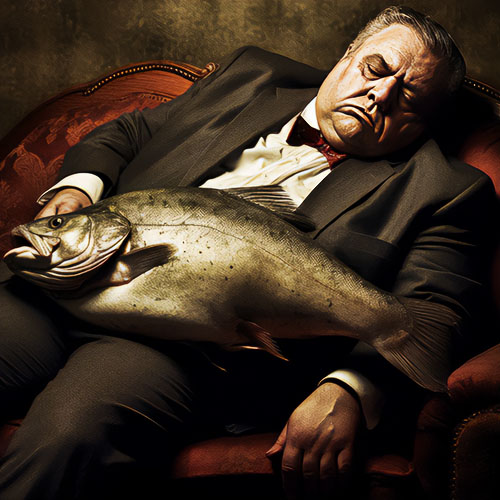Thousands of hawks are beaten to death every year, and federal agent Ed Newcomer thrives on tracking down the killers. But more than that he and his fellow wildlife cops love the animals they protect.
The Wild Bunch
The seedy Los Angeles parking lot of the McDonald’s at Sunset and Western, an intersection strewn with trash, the restaurant grounds protected by a high fence from the street scene, is a locale crowded with a collection of characters actively engaged in what a friend of mine calls “skulking with intent to lurk.” My appointment there was with U.S. Fish and Wildlife Service Special Agent Ed Newcomer. Ed had called me and asked if I wanted to witness the type of surveillance work he does to build cases against violators of fish and game laws.
“Wear boots and grubby clothes,” he had warned.
For a year, Ed had been working undercover infiltrating local rollerpigeon clubs. Roller pigeons get their name from the odd behavior they exhibit of falling and rolling in flight. Aficionados breed the pigeons to roll and fall as much as possible without crashing to the ground. During competitions, trainers get points for their pigeons based on the number and style of rolls they make while flying in circles with other birds. The trouble is, hawks eat pigeons, and when pigeons are rolling and falling they look as if they are in distress and, hence, easy prey. There are some 250 roller-club members in Los Angeles and, during his investigation, Ed found only one who said he refused to kill the pursuing hawks.
Urban Los Angeles is home to a vibrant community of hawks. As Ed became “one of the guys” at the three pigeon clubs he joined, pigeon trainers freely explained the hawk problem to him. And they freely told him that they trapped, shot, poisoned, and clubbed hawks. Ed set up surveillance cameras pointed at club members’ homes and secured footage of his new colleagues baiting traps and catching hawks. They then shot or beat the hawks to death.
He had pictures of them dumping the dead birds – with gunshot wounds or blunt-force trauma – into their garbage cans, birds Ed and his crew gathered from the garbage for evidence.
I followed Ed’s undercover car up into the Hollywood Hills, a short hop from the squalor of Sunset and Western to the multimillion-dollar homes with sweeping views of the Los Angeles Basin. We parked at a quiet corner, and Ed pulled on his bulletproof vest. FEDERAL AGENT was written in big, bright letters on the back, and he wore a badge over his heart. His semiautomatic pistol and handcuffs were on his belt. He stashed night-vision binoculars in his backpack and briefed me on what to expect as I followed him. We were going to hike a few hundred yards up a culvert that runs between the swank homes, continuing up the hill until we were looking into the backyard of the national president of the leading roller-pigeon club.
“Since I’ve got the vest, if there’s any trouble just stay behind me,” Ed suggested. His biggest concern was that we would stumble upon a homeless person living in the culvert who would consider us trespassers on his property, but he also mentioned that if the homeowner we were spying on saw us, that, too, could turn ugly. We walked half a block down the sidewalk. During a break in traffic, Ed motioned for me to follow him.
He had already alerted the LAPD that we were in the neighborhood so that if a citizen spotted the two of us prowling around, the city cops would know why. We scaled a cyclone fence and headed toward our prey.
“Keep down,” Ed warned as we hiked. We could see in the windows of the homes; presumably they could see us on this warm night with a cloud cover that reflected the city lights.
“Try to be quiet,” he said as my footsteps snapped branches and what sounded like discarded Styrofoam containers. When we arrived at the backyard in question, Ed retrieved the night scopes. He eased up to the fence and looked over. No trap was where he had last observed one. He panned the yard and found it, moved behind a tree. He motioned me over and I looked through the binoculars. The night turned bright as day, and where he had pointed was the wiremesh trap, waiting to snag a hawk.
I gave Ed a thumbs-up and we headed down to the street. Each day he can witness a baited hawk trap, it’s another criminal count.When we arrived back at the car, Ed pulled off his vest. “Was that fun?” he asked. This is a man who clearly loves his work, but it’s not just the thrill of the chase. He loves the animals he protects. While he was packing up the binoculars, he glanced across the street and pointed. His voice was excited: “Look! A coyote!” And sure enough, a scrawny coyote was ambling down the sidewalk, another example of the urban-wildlife interface that is Los Angeles.
A couple of days later, Ed and I met again at Sunset and Western, this time just after dawn and accompanied by backup: other Fish and Wildlife agents, California Department of Fish and Game wardens, and LAPD officers. Ed had his warrants and we were poised to arrest a man we’ll call Robert Harris, the president of a local roller club, for killing hawks. Ed’s easy smile was gone as he gathered his troops for a pre-raid briefing, filling them in first on the crime and then on his strategy for the arrest. Fish and Game specialists estimate about 1,500 hawks are killed each year by pigeon racers in Los Angeles alone. “Look for talons,” Ed instructed regarding evidence.
Pigeon-owner hawk killers cut off talons as trophies and give them away as gifts; some hang them from their cars’ rearview mirrors instead of fuzzy dice. Possessing any part of a falcon or hawk is a violation of the Migratory Bird Treaty Act. Harris had bragged to Ed that he kills 40 to 50 hawks a year, saying, “I don’t shoot’em; I hit’em with a stick.” He was concerned that gunfire would disturb his upscale neighbors.
The plan was to get up to Harris’s house before he left for the day. Our seven-car motorcade raced to Harris’s neo-Tudor house and its perfectly manicured lawn and garden. The LAPD officers jumped out and secured the perimeter. Ed knocked on the front door, warrant in hand. “Police!” he barked out.
“Open the door!” It opened a crack, and the surprised and scared maid said a soft, “Que?” While agents flooded the backyard and searched, a Spanish-speaking agent convinced the maid to call Harris. He said he’d be back in ten minutes. During the wait, Ed and his team located the trap baited with a live pigeon, and found a dead hawk in a garbage can.
“Here he comes,” one of the LAPD officers called out as Harris’s car came up the hill. It pulled into the driveway and a female agent, her badge and gun backing up the FEDERAL AGENT scrawled across her bulletproof vest, approached the driver. “Are you Robert Harris?” As soon as he said yes, she told him, “You’re under arrest.”
A handcuffed Harris – in an elegant sport jacket and slacks, looking bewildered – was led over to an unmarked Fish and Wildlife Chevy Tahoe, and belted into the backseat. He appeared shocked as she read him his Miranda rights, complaining that he didn’t know why he was being arrested. “Migratory Bird Treaty violations,” she told him. Another female agent joined her at the squad car, and the two of them began questioning him. Here we were, just above Hollywood, and the scene was cinematic: two blondes with movie-star looks interrogating a confused and trapped suspect, a man accustomed to being in charge and instead cowering in fear.
I watched and listened as Harris meekly squawked excuses and denials to their queries about the trap and the hawks he caught. But while he was insisting over and over that he took any hawks caught in the trap out to the desert and released them far from his pigeons, other agents were digging into his garbage cans, where they found a freshly killed hawk.
“Happy?” I asked Ed as the Tahoe pulled away, hauling the still shocked and pale-looking Harris downtown for booking.
“Oh, yeah,” he smiled. “We found a hawk in the garbage, and that’s the quintessential body in law enforcement.” He said he was sure his crime lab would prove it was killed by bluntforce trauma, as he preened again,
“We have the body!”
In November 2007, Harris plead guilty to 76 counts of violating the Migratory Bird Treaty Act. He was sentenced to, among other things, 780 days in jail (which was suspended provided he did not violate the terms of probation during a five-year period), a $70,000 fine, $75,000 restitution payable to the Los Angeles Audubon Society Chapter’s Rap tor Rehabilitation Compensation Fund, surrender of his hawk trap and .22 caliber rifle, and published apologies in two consecutive issues of his club’s bulletin.
























